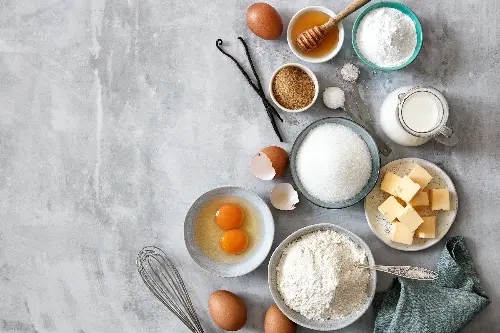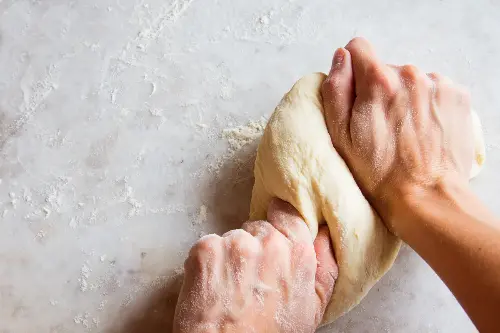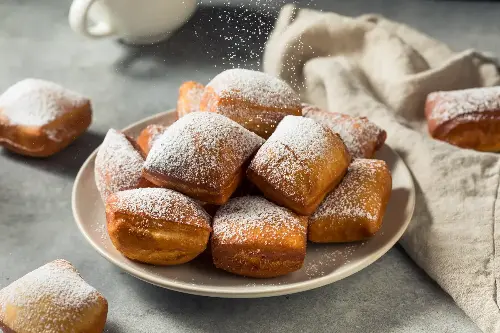
Indulge in the exquisite taste of France with a simplified recipe for fluffy and airy beignets that promise to sway your senses and transport you to the quaint streets of Paris with every bite. Beignets, a French confectionery marvel, have long delighted palates around the world with their delicate texture and sumptuous flavour. In this article, we will guide you through the art of crafting these delectable treats with ease and finesse.
Beignets are traditionally prepared from choux pastry, a light dough that puffs up in cooking, creating a soft and hollow centre. However, the version we will focus on derives from a yeast dough, giving rise to a pillow-like interior and a golden-brown exterior once fried.
To begin your culinary adventure, let's start with assembling the key ingredients you'll need: 500 grammes of all-purpose flour, 50 grammes of granulated sugar, 1 teaspoon of salt, 7 grammes of active dry yeast, 2 large eggs, 240 millilitres of warm whole milk, and 2 tablespoons of unsalted butter at room temperature. Additionally, for frying, a neutral oil such as vegetable or canola is ideal, and to finish, a generous dusting of powdered sugar is essential for that authentic French touch.

First, activate the yeast by combining it with the warm milk and a pinch of sugar. The temperature of the milk is crucial; it should be warm but not hot to the touch, roughly 45 degrees Celsius. Stirring gently, allow the mixture to sit for about 5 to 10 minutes until frothy, indicating that the yeast is alive and ready to do its job.
In the meanwhile, in a large mixing bowl or stand mixer, whisk together the flour, remaining sugar, and salt. Once the yeast mixture has proofed, add this to the dry ingredients along with the eggs. The wet and dry elements should come together to form a sticky dough. At this juncture, add the soft butter in increments, fully incorporating after each addition.
Kneading is next, and it's a step that requires a bit of elbow grease or the trusty work of a dough hook attachment on a mixer. Knead the dough for about 5 minutes or until it's smooth and elastic. It's important not to rush this step, as kneading develops the gluten in the dough, leading to the coveted light and airy texture of the finished beignets.

After kneading, place the dough into a lightly oiled bowl, cover it with a clean kitchen towel or plastic wrap, and let it rise in a warm spot. You're looking for the dough to double in size, which typically takes 1 to 2 hours depending on the ambient temperature.
Once risen, gently turn out the dough onto a lightly floured surface and roll it out to about a 1/2 inch thickness. Here, you can wield your creativity; cut the dough into classic squares or diamonds, or perhaps use a cookie cutter for playful shapes.
Another critical phase is the second proofing. Arrange the cut dough pieces on a floured baking sheet, allowing adequate space between them for expansion. Cover them with a lightweight kitchen towel and let them rest for another 45 minutes to an hour. They will puff up slightly, a hint that they are ready for their hot oil bath.
For frying, heat your oil to 175 degrees Celsius in a deep fryer or a large heavy-bottomed pot, using a candy thermometer to accurately gauge the temperature. Fry the beignets in batches, careful not to overcrowd the pot, flipping them occasionally. This will take about 2 to 3 minutes until they are a perfect golden brown colour. Ensure the oil temperature remains consistent for even cooking.

Once fried, transfer your golden treasures to a cooling rack set over a baking sheet to drain any excess oil. While they're still warm, dust liberally with powdered icing sugar. Be generous; it's not only traditional, but it also adds to the beignets' irresistible charm.
Savour your homemade beignets with a hot cup of coffee or chicory, as is customary in New Orleans, where French-inspired beignets have also made their mark. They're an ideal treat for breakfast, brunch, or a delightful afternoon snack.
In perfecting the simple art of beignet-making, you open a door to a world of French-inspired indulgence. This recipe calls for patience and love, and the result is nothing short of delightful. Bon appétit!
